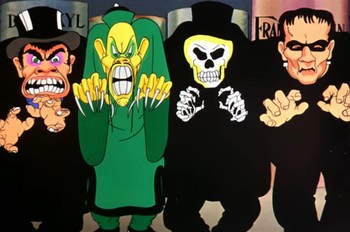
Don't let their scariness fool you, they're here to dance.
Have You Got Any Castles? is a 1938 Merrie Melodies cartoon, directed by Frank Tashlin.
The cartoon has no plot to speak of, and is mainly a spot gag picture consisting of random jokes and puns on 1930's pop culture, with the only theme tying it together is that it's set in a bookstore where the characters of each book come to life for a night of fun.
Tropes:
- Adipose Rex: Old King Cole.
- Bowdlerization:
- After this film's initial release, Alexander Woollcott, the voice of the town crier, requested that his caricature in this cartoon be cut for reissue after his death, leading to a lot of scenes from the opening and closing to be missing. The cuts were later restored when the cartoon was released on the Looney Tunes Golden Collection DVD set (second volume).
- On TBS, in addition to the above cuts made for the reissue, the following scenes were cut:
- Caricatures of Bill "Bojangles" Robinson tap dancing in a book called The 39 Steps, and the immediate next scene of Cab Calloway singing "I've Got Swing For Sale", reused from the Censored Eleven short "Clean Pastures"note
- Rip van Winkle twice stealing scissors from "The Valiant Little Tailor" and using them to cut Uncle Tom's hair to use as earplugs (the second time resulting in Uncle Tom punching Rip van Winkle in the face and cutting his beard off).
- Cuckoo Clock Gag: The short opens with a cuckoo clock coming out and signaling the time for the book denizens to come out and play. At the end, the bird comes out again to signal the time to go, but its beak has been wrapped shut so Rip Van Winkle can finally get some sleep.
- Digital Destruction: The Golden Collection release of the cartoon, despite restoring the cartoons missing footage, is loaded with DVNR and nasty digital interlacing problems.
- Hurricane of Puns: The primary source of the cartoon's humor. It even climaxes with a literal whirlwind from the book Gone with the Wind.
- Mood Whiplash: A gag early in the film involves Mr. Hyde, Fu Manchu, The Phantom of the Opera and Frankenstein's Monster coming out of their books to roar at the audience—only to break out into a lighthearted dance number with each other.
- No Celebrities Were Harmed: Many of the pop culture gags are based on caricatures of famous movie stars of the time period.
- Parody: Of the cliche "Things Come to Life In a Bookstore" cartoon genre of the time.
- Public Domain Animation: The cartoons copyright expired years ago, but for many years, only edited prints were in circulation.
- Random Events Plot: There is no story; it's just a string of reference gags and puns with the Alexander Woollcott caricature (on the versions where he's actually shown) serving as a framing device.
- Rubberhose Limbs: Oliver Twist is drawn with these, since the joke is that he's literally twisting like a noodle.
- Shout-Out:
- Even by the standards of Looney Tunes shorts, this cartoon is truly a reference bonanza, second only to "Hollywood Steps Out". The whole cartoon is an encyclopedia of 1930's pop culture references and in-jokes to Looney Tunes staff of the time.
- Here's a list: it features Alexander Woollcott (in character as a "Town Crier"), Bill "Bojangles" Robinson (dancing on The 39 Steps), Greta Garbo (her feet are So Big), Cab Calloway, Fats Waller, The Mills Brothers, William Powell, Clark Gable (in The House of the Seven Gables), Paul Muni, Charles Laughton, Victor McLaglen, W. C. Fields, and Ned Sparks (as Rip Van Winkle). The globe on the cover of Pearl Buck's book The Good Earth (1937) mentions "Papa Leon and Uncle Ray", referring to Leon Schlesinger, who was the executive producer of the Looney Tunes shorts then, and Raymond Katz, Schlesinger's brother-in-law, who also worked at the studio. The book and movie references include Uncle Tom's Cabin (1927), Bulldog Drummond (1929), All Quiet on the Western Front (1930), So Big! (1932), Mr. Robinson Crusoe (1932), Oliver Twist (1933), Little Women (1933), The Count of Monte Cristo (1934), Little Men (1934), So Red the Rose (1935), The 39 Steps (1935), The Three Musketeers (1935), Seven Keys to Baldpate (1935), Under Two Flags (1936), The Last of the Mohicans (1936), The Charge of the Light Brigade (1936), Three Men on a Horse (1936), Hi-De-Ho (1937), Seventh Heaven (1937), The Road Back (1937), Topper (1937), The Prisoner of Zenda (1937), Bulldog Drummond Comes Back (1937), Varsity Show (1937) The Hurricane (1937), The Phantom of the Opera (1925), Rio Rita (1929), Frankenstein (1931), Dr. Jekyll and Mr. Hyde (1931) (1931), The Mask of Fu Manchu (1932), The Private Life of Henry VIII. (1933), The Invisible Man (1933), The Informer (1935), Diamond Jim (1935), The Story of Louis Pasteur (1936), The Green Pastures (1936), Heidi (1937) and last, but not least, Gone with the Wind.
- Besides the pop culture jokes, the artists snuck in a lot of names of their staff. A comprehensive list of who is referenced can be found here.

- Standard Snippet: Gossec's "Gavotte in D Major" is used when the monsters abruptly start dancing.
- Title Drop: Done by the Three Musketeers in the fourth musical number's opening lines. "Have you got any castles that you want me to build, baby?"
